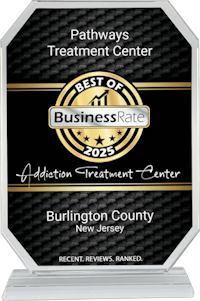Fentanyl Addiction
Treatment in Burlington, New Jersey
Fentanyl is a powerful synthetic opioid pain medication that is used in medical contexts to treat severe pain. However, its potency also makes it highly addictive and dangerous. It’s also emerged as a dangerous additive to many drugs, including Adderall and various opioids. Fentanyl addiction is a severe form of substance use disorder, requiring comprehensive treatment to address both physical and psychological aspects.
Fentanyl works by binding to opioid receptors, blocking pain signals, and producing feelings of euphoria and relaxation. Originally developed in the 1960s, fentanyl has since become a widely used medication for managing acute and chronic pain. Due to its potency, fentanyl carries a high risk of overdose, especially when used improperly or in combination with other substances like alcohol or benzodiazepines. In recent years, there has been a concerning rise in fentanyl-related overdose deaths, leading to increased efforts to educate the public about the dangers of this powerful drug.
It’s important for healthcare providers to carefully monitor patients prescribed fentanyl to prevent misuse and diversion. Additionally, naloxone, a medication that can rapidly reverse opioid overdose, is often recommended to be available to those who are prescribed fentanyl in case of emergency. Understanding the risks and benefits of fentanyl is crucial in ensuring safe and effective pain management for those in need of its powerful pain-relieving effects.

Why is Fentanyl Dangerous?
Fentanyl can cause respiratory depression, leading to shallow breathing or even respiratory arrest. This suppression of the respiratory system can be life-threatening, especially when combined with other central nervous system depressants like alcohol or benzodiazepines. The risk of overdose and fatality is alarmingly high with fentanyl use.
Moreover, fentanyl’s addictive properties contribute to its danger. The drug can create a rapid tolerance in users, leading to increased doses to achieve the same effect. This cycle of escalating dosage can quickly spiral out of control, increasing the likelihood of overdose and death. The intense euphoria produced by fentanyl can also make it psychologically addictive, driving individuals to seek out the drug despite knowing the risks.
Furthermore, the illicit production and distribution of fentanyl add another layer of risk. The lack of quality control in underground labs means that each batch of fentanyl can vary widely in potency, increasing the chances of accidental overdose. The clandestine nature of fentanyl production also means that users are often unaware of the drug’s purity or the presence of dangerous additives, further heightening the potential dangers associated with its consumption.
Fentanyl's Role as a Drug Additive
Certain other addictive substances, including alcoholic beverages, can multiply the strength of fentanyl. This can prove fatal for overdoses, especially if other drugs are “cut” with added fentanyl to reduce price or make a supply go further. Fentanyl is also dangerously versatile because it can be distributed into the body in many ways. In addition to pills, fentanyl can also be injected or transmitted through the skin.
How Do People Get Addicted to Fentanyl?
People are often attracted to fentanyl due to its intense euphoric effects. The body develops a tolerance to the drug over time, requiring higher and more frequent doses to achieve the desired effect. This cycle of escalating use can quickly lead to addiction.
Signs of Fentanyl Addiction
- Changes in mood and behavior
- Drowsiness
- Constricted pupils
- Confusion
- Increased drug-seeking behavior
- Withdrawal symptoms when not using
- Neglecting responsibilities or obligations
- Social withdrawal and isolation
- Financial difficulties due to increased drug purchasing
Fentanyl addiction can have devastating consequences on a person’s physical and mental health. Prolonged use of fentanyl can lead to respiratory depression, where breathing becomes dangerously slow and shallow. This can result in hypoxia, where the body is deprived of adequate oxygen supply and eventually shuts down.
Aside from the signs mentioned above, other indicators of fentanyl addiction may include respiratory depression, drowsiness, confusion, and constricted pupils. Long-term use of fentanyl can lead to tolerance, where higher doses are needed to achieve the same effects. This can drastically increase the risk of overdose and other serious complications.
How a Rehabilitation Program Can Help with Fentanyl Addiction
In treatment programs designed to help individuals fight addiction, the structured format can be helpful to those combating addiction. Attending support groups as part of an outpatient program can provide accountability and focus for a person in the early stages of overcoming addiction. A structured treatment program can provide medication-addicted treatment, which can help alleviate withdrawal symptoms.
Recovery from fentanyl addiction is challenging but not impossible. A comprehensive disorder treatment program can provide the support, resources, and therapies necessary for individuals to overcome addiction and build a foundation for a drug-free life. For people dealing with a mental illness, a program can provide dual diagnosis treatment that addresses the interaction between mental illness and addiction.

Stages of Fentanyl Withdrawal Symptoms
The stages of fentanyl withdrawal generally go as follows:
- Early withdrawal: Within four hours of the last dose, individuals may experience anxiety, restlessness, and muscle aches.
- Peak withdrawal: Up to two days after quitting, withdrawal symptoms peak and may include nausea, vomiting, diarrhea, insomnia, and intense cravings.
- Gradual improvement: After about five days, physical symptoms begin to subside, but cravings and emotional symptoms may persist. Individuals may experience an inability to experience pleasure, increased negative feelings, or a burst of optimism.
- Continued recovery: Ongoing support and treatment are essential after the initial detox. Individuals may experience initial withdrawal symptoms up to ten days after stopping use.
It is important to note that the severity and duration of withdrawal symptoms can vary depending on the individual and the extent of their addiction. Medical professionals emphasize the importance of closely monitoring individuals undergoing detox to prevent complications, and to provide necessary medications to manage the symptoms effectively.

Recover From Fentanyl and Opioid Addiction at Pathways Treatment Center
We feature comprehensive treatment programs, including partial hospitalization and multiple outpatient options, in addition to sober living options for post-treatment support. Our work addresses the physical, emotional, and psychological aspects of addiction. We believe in treating the whole person and empowering individuals to overcome addiction and reclaim their lives.
Fentanyl doesn’t have to rule your decisions. It is possible to detoxify and learn how to cope with life’s troubles without it. Contact Pathways Treatment Center today to take the first step towards a healthier, happier future.


